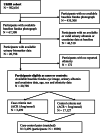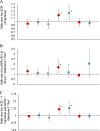Investigation of associations between retinal microvascular parameters and albuminuria in UK Biobank: a cross-sectional case-control study
- PMID: 33632154
- PMCID: PMC7908698
- DOI: 10.1186/s12882-021-02273-6
Investigation of associations between retinal microvascular parameters and albuminuria in UK Biobank: a cross-sectional case-control study
Abstract
Background: Associations between microvascular variation and chronic kidney disease (CKD) have been reported previously. Non-invasive retinal fundus imaging enables evaluation of the microvascular network and may offer insight to systemic risk associated with CKD.
Methods: Retinal microvascular parameters (fractal dimension [FD] - a measure of the complexity of the vascular network, tortuosity, and retinal arteriolar and venular calibre) were quantified from macula-centred fundus images using the Vessel Assessment and Measurement Platform for Images of the REtina (VAMPIRE) version 3.1 (VAMPIRE group, Universities of Dundee and Edinburgh, Scotland) and assessed for associations with renal damage in a case-control study nested within the multi-centre UK Biobank cohort study. Participants were designated cases or controls based on urinary albumin to creatinine ratio (ACR) thresholds. Participants with ACR ≥ 3 mg/mmol (ACR stages A2-A3) were characterised as cases, and those with an ACR < 3 mg/mmol (ACR stage A1) were categorised as controls. Participants were matched on age, sex and ethnic background.
Results: Lower FD (less extensive microvascular branching) was associated with a small increase in odds of albuminuria independent of blood pressure, diabetes and other potential confounding variables (odds ratio [OR] 1.18, 95% confidence interval [CI] 1.03-1.34 for arterioles and OR 1.24, CI 1.05-1.47 for venules). Measures of tortuosity or retinal arteriolar and venular calibre were not significantly associated with ACR.
Conclusions: This study supports previously reported associations between retinal microvascular FD and other metabolic disturbances affecting the systemic vasculature. The association between retinal microvascular FD and albuminuria, independent of diabetes and blood pressure, may represent a useful indicator of systemic vascular damage associated with albuminuria.
Conflict of interest statement
The authors declare that they have no competing interests.
Figures


References
Publication types
MeSH terms
Grants and funding
LinkOut - more resources
Full Text Sources
Other Literature Sources

